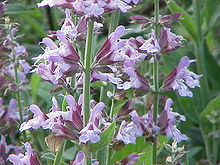| Salvia | |
|---|---|

| |
| Common sage (Salvia officinalis) | |
| Scientific classification | |
| Kingdom: | Plantae |
| Clade: | Tracheophytes |
| Clade: | Angiosperms |
| Clade: | Eudicots |
| Clade: | Asterids |
| Order: | Lamiales |
| Family: | Lamiaceae |
| Subfamily: | Nepetoideae |
| Tribe: | Mentheae |
| Genus: | Salvia L.[1] |
| Type species | |
| Salvia officinalis | |
| Species | |
| Synonyms[2] | |
|
List
| |
Salvia (/ˈsælviə/)[3] is the largest genus of plants in the sage family Lamiaceae, with nearly 1,000 species of shrubs, herbaceous perennials, and annuals.[4][5][6] Within the Lamiaceae, Salvia is part of the tribe Mentheae within the subfamily Nepetoideae.[4] One of several genera, commonly referred to as sage, it includes two widely used herbs, Salvia officinalis (common sage, or just "sage") and Salvia rosmarinus (rosemary, formerly Rosmarinus officinalis).
The genus is distributed throughout the Old World and the Americas (over 900 total species), with three distinct regions of diversity: Central America and South America (approximately 600 species); Central Asia and the Mediterranean (250 species); Eastern Asia (90 species).[4]
- ^ "Salvia L." Germplasm Resources Information Network. United States Department of Agriculture. 2004-09-10. Retrieved 2009-12-15.
- ^ "Salvia L." Plants of the World Online. Royal Botanic Gardens, Kew. Retrieved 2024-01-09.
- ^ "salvia". Merriam-Webster.com Dictionary. Merriam-Webster.
- ^ a b c Cite error: The named reference
Walkerwas invoked but never defined (see the help page). - ^ Sutton, John (2004). The Gardener's Guide to Growing Salvias. Workman Publishing Company. pp. 15–17. ISBN 978-0-88192-671-2.
- ^ Clebsch & Barner 2003, p. 18.